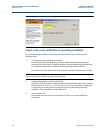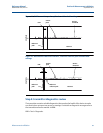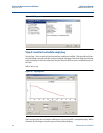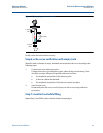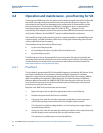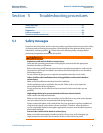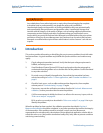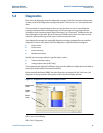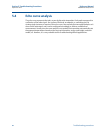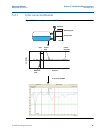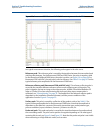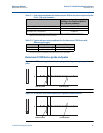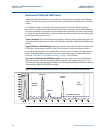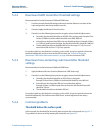
62
Reference Manual
00809-0700-4530, Rev AA
Section 5: Troubleshooting Procedures
September 2013
Troubleshooting procedures
5.2 Introduction
This section provides information on identifying the most common problems found with radar
level transmitters. A typical workflow may look like this (local restrictions and variations may
apply):
1. Check voltage at transmitter terminals. Verify that the input voltage requirement is
fulfilled, and wiring is correct.
2. View Distributed Control System (DCS) trends and question the relevant people to
understand when the problem occurs and the effect of the problem. Could it be related
to any other activities?
3. Do a tank survey to identify the application. Ensure that the transmitter has been
selected according to Section 1: Power applications, and “Chamber installations” on
page 6.
4. Check for basic errors, such as cables and transmitter diagnostics, then complete
relevant parts of “Commissioning” on page 35 again.
5. If necessary, execute the verification procedure described in Section 4: Measurement
validation, or other procedure that recreates the problem.
6. A) If the measurement is reliable, but there is an offset or the accuracy is poor, refer to
“Echo curve analysis” on page 64.
B) Do an echo curve analysis as described in “Echo curve analysis” on page 64 to try to
identify the problem.
When the problem has been resolved, the validation procedure described in Section 4:
Measurement validation should be completed, or any other procedure that verifies the integrity
of the transmitter. If the problem cannot be resolved, contact your local Rosemount
representative for assistance with a description of the problem and application, also be able to
submit the echo curve (.dat) and the transmitter backup file (.bak), taken at present conditions
and during commissioning.
Any substitution of non-authorized parts or repair, other than exchanging the complete
transmitter head or probe assembly, may jeopardize safety and is prohibited.
Unauthorized changes to the product are strictly prohibited as they may unintentionally
and unpredictably alter performance and jeopardize safety. Unauthorized changes that
interfere with the integrity of the welds or flanges, such as making additional perforations,
compromise product integrity and safety. Equipment ratings and certifications are no
longer valid on any products that have been damaged or modified without the prior written
permission of Emerson Process Management. Any continued use of product that has been
damaged or modified without prior written authorization is at the customer’s sole risk and
expense.



